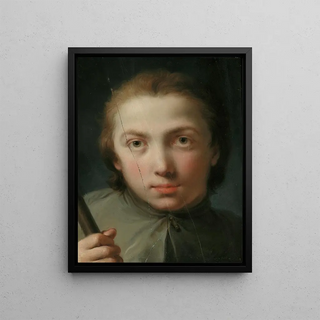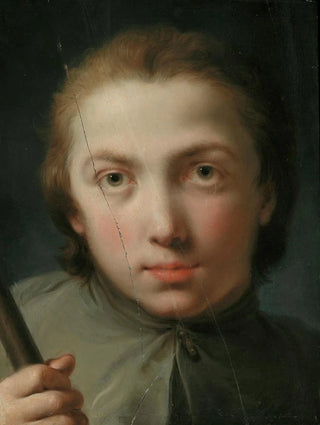Art print | Head of a Boy - Gaetano Gandolfi


View from behind

Frame (optional)
Reproduction of Head of a Boy - Gaetano Gandolfi – Captivating Introduction
The "Head of a Boy" by Gaetano Gandolfi is a piece that invites contemplation and wonder. This portrait, imbued with softness and delicacy, captures the very essence of childhood through the pure and innocent gaze of the young boy depicted. This artwork not only demonstrates the artist's technical skill but also his ability to convey deep emotions. Observing this piece transports the viewer into a universe where time seems suspended, revealing the fleeting beauty of childhood.
Style and uniqueness of the work
Gandolfi's style is distinguished by remarkable finesse and meticulous attention to detail. In "Head of a Boy," subtle nuances of color and play of light accentuate the facial features, creating an atmosphere that is both serene and vibrant. The artist employs a chiaroscuro technique that highlights shadows and highlights, giving the figure a striking volume. This portrait is not merely a simple representation; it evokes psychological depth, where each gaze, each expression tells a story. The almost neutral background allows the child's face to flourish, drawing attention to the innocence and purity emanating from his gaze. This work is thus a perfect example of the ability of art to capture fleeting moments and immortalize them on canvas.
The artist and his influence
Gaetano Gandolfi, born in 1734 in Bologna, is a painter whose work is rooted in the tradition of Neoclassicism, while incorporating Baroque elements. Trained in his father's studio, also an artist, he developed a personal style that combines finesse and expressiveness. His mastery of portraits earned him recognition throughout Italy, and he was a privileged witness to the artistic evolutions of his time. With works that oscillate between intimacy and grandeur, Gandolfi influenced many contemporary and later artists. His approach to portraiture, which combines realism and idealization, paved the way for a new way of representing the human figure.

Matte finish

View from behind

Frame (optional)
Reproduction of Head of a Boy - Gaetano Gandolfi – Captivating Introduction
The "Head of a Boy" by Gaetano Gandolfi is a piece that invites contemplation and wonder. This portrait, imbued with softness and delicacy, captures the very essence of childhood through the pure and innocent gaze of the young boy depicted. This artwork not only demonstrates the artist's technical skill but also his ability to convey deep emotions. Observing this piece transports the viewer into a universe where time seems suspended, revealing the fleeting beauty of childhood.
Style and uniqueness of the work
Gandolfi's style is distinguished by remarkable finesse and meticulous attention to detail. In "Head of a Boy," subtle nuances of color and play of light accentuate the facial features, creating an atmosphere that is both serene and vibrant. The artist employs a chiaroscuro technique that highlights shadows and highlights, giving the figure a striking volume. This portrait is not merely a simple representation; it evokes psychological depth, where each gaze, each expression tells a story. The almost neutral background allows the child's face to flourish, drawing attention to the innocence and purity emanating from his gaze. This work is thus a perfect example of the ability of art to capture fleeting moments and immortalize them on canvas.
The artist and his influence
Gaetano Gandolfi, born in 1734 in Bologna, is a painter whose work is rooted in the tradition of Neoclassicism, while incorporating Baroque elements. Trained in his father's studio, also an artist, he developed a personal style that combines finesse and expressiveness. His mastery of portraits earned him recognition throughout Italy, and he was a privileged witness to the artistic evolutions of his time. With works that oscillate between intimacy and grandeur, Gandolfi influenced many contemporary and later artists. His approach to portraiture, which combines realism and idealization, paved the way for a new way of representing the human figure.






